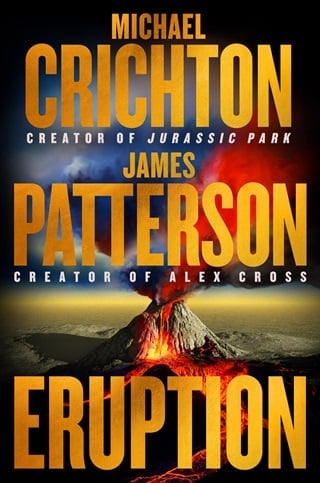Chapter 5
John MacGregor knew who he was and what his strengths were. Public speaking was not one of them. He cleared his throat and nervously tapped the microphone.
"Good afternoon. I'm John MacGregor, scientist in charge of the Hawaiian Volcano Observatory. Thank you all for coming today."
He turned to the map. "As you know, this observatory monitors six volcanoes—the undersea volcano Kama‘ehuakanaloa, formerly Lō‘ihi; Haleakalā, on Maui; plus four on the Big Island of Hawai‘i, including the two active volcanoes, Kīlauea, a relatively small volcano that has been continuously active for over forty years, and Mauna Loa, the largest volcano in the world, which erupted in 2022 but has not had a major eruption since 1984."
On the map, Kīlauea was a small crater alongside the laboratory building. Mauna Loa looked like a huge dome; its flanks occupied half the island.
Mac took a deep breath and exhaled. The microphone picked up the sound.
"Today," MacGregor said, "I am announcing an imminent eruption of Mauna Loa."
The photographers' strobe lights were like flashes of lightning. MacGregor blinked away the white spots in front of his eyes, cleared his throat again, and kept going. He'd probably only imagined that the television lights had just gotten brighter.
"We expect this to be a fairly large eruption," he said, "and we expect that it will come within the next two weeks, perhaps much sooner than that."
He held up a hand to quiet the suddenly elevated noise level from the audience and pivoted toward Jenny, who put up the seismic data on an easel to his left. The image, which plotted the epicenters of all the earthquakes on the island during the last year, showed dark clusters around the summit.
"According to the data we have gathered and analyzed, this eruption will most likely occur at the summit caldera," MacGregor continued, "which means that the city of Hilo should not be affected. Now I'm happy to take any questions you have."
The hands went up. Mac didn't do a lot of major press conferences, but he knew the rules of the road, one of which was that local news always got the first question.
He pointed to Marsha Keilani, the reporter from KHON in Hilo. "Mac, you said a ‘fairly large eruption.' Just how large, exactly?" She smiled. "Asking for some friends."
"We expect it to be at least as large as the 1984 eruption that produced half a billion cubic meters of lava and covered sixteen square miles in three weeks," he said. "In fact, this eruption may be much larger, perhaps as large as the eruption of 1950. We just don't know at this point."
"But you obviously have an idea about timing or we wouldn't be here," she said. "So are we talking about two weeks? Or sooner?"
"Could be sooner, yes. We've been combing through all the data, but there's still no way to predict the exact timing of an eruption." He shrugged. "We're just not sure."
Keo Hokulani from the Honolulu Star-Advertiser was next. "Dr. MacGregor, aren't you hedging a little? You have very sophisticated equipment here. You're quite sure of the size and timing, aren't you?" Keo knew that because he'd toured the HVO a few months earlier. He'd seen all the latest computer models and projections and knew his stuff.
"As you know, Keo, Mauna Loa is one of the most intensely studied volcanoes in the world. We have tiltmeters and seismometers all over it, drones flying thermal cameras, satellite data in thirty-six frequencies, radar, and visible- and infrared-light sensors." He shrugged and grinned. "Having said that, yeah, I am hedging." They all laughed. "Volcanoes are a little—or a lot—like wild animals. It's difficult and dangerous to predict how they'll behave."
Wendy Watanabe from one of the Honolulu TV stations raised a hand.
"In the 1984 eruption," she said, "lava came quite close to Hilo, and people felt threatened. So are you saying that this time there is no danger to Hilo?"
"That's correct," MacGregor said. "The lava in '84 came within four miles of Hilo, but the main lava flows were east. As I said, this time we expect most of the lava to flow away from Hilo." He turned and pointed at the map, feeling like a weatherman on the local news. "This means it will flow down the north slope into the center of the island, the saddle between Mauna Loa and Mauna Kea. This is a big and—fortunately—largely uninhabited area. Mauna Kea Science Reserve has several observatories at twelve thousand feet, and the army runs a large training area over there, at six thousand feet, but that's all. So I want to reiterate: This eruption will not threaten Hilo residents."
Wendy Watanabe put up her hand again. "At what point will HVO raise the volcano alert level?"
"While Mauna Loa is at elevated unrest, the level remains at advisory/yellow," MacGregor said. "We remain focused on the northeast rift zone."
A reporter he didn't recognize asked, "Will Mauna Kea erupt as well?"
"No. Mauna Kea is dormant. It hasn't erupted for about four thousand years. As you know, the Big Island has five volcanoes, but only two are currently active."
Standing by his side, Jenny Kimura gave a quiet sigh of relief and smiled. It was going as well as she could have hoped. The reporters weren't being sensationalistic, and Mac seemed comfortable, sure of himself and his information. He was speaking effortlessly, sliding past the issues they didn't want to cover. She thought he'd handled questions about the size of the eruption particularly well.
Mac had managed to stay on point and not stray into the weeds like he sometimes did. Jenny knew her chief's tendencies. Before coming to Hawai‘i, John MacGregor had been a member of the United States Geological Survey advisory team, which was sent all over the planet to wherever there was an impending eruption. Starting in his student days, he'd been present at all the famous ones. MacGregor had been at Eyjafjallaj?kull and Mount Merapi in 2010, Puyehue-Cordón Caulle in 2011, Anak Krakatau in 2018, and Hunga Tonga-Hunga Ha‘apai in 2022. And he had seen very bad things. All because, as he put it, "People waited too long, which means until it was too late."
MacGregor's experiences had left him with a blunt, chin-out, do-it-now attitude and a willingness to plan for worst-case scenarios. He was a cautious scientist but a quick, decisive administrator who tended to act first and worry about consequences later. He was that sure of himself.
Mac was extremely well respected at HVO, but sometimes Jenny was left to pick up the pieces after his shotgun decisions. She couldn't remember how many times she had said, "Uh, well…" after hearing one of his spontaneous ideas.
But no one could argue that he wasn't generous or didn't care about people. He'd been a troubled kid himself, which was why he'd become a surfing coach for local troubled kids. While coaching the boys, he tried to motivate some of them to work harder at school and others to stay in school; he'd even gotten a few of them into the intern program at HVO. And he always followed their careers after they left HVO for various universities.
And then there was his unmatched experience. Everybody else on the HVO staff had seen these famous eruptions on videotape. MacGregor had been there. If he was acting this quickly and decisively now, he had his reasons. He'd been there. He knew.
He also knew enough not to explain in detail that HVO was tracking the biggest eruption in a century—that would only have caused a panic, no matter which side of the volcano was going to blow.
There was one other thing that Mac knew and Jenny knew but the media didn't.
John MacGregor was lying his ass off.
He knew exactly when the eruption was coming, and it wasn't two weeks or even one.
Five days.
And counting.
 Fullepub
Fullepub 



